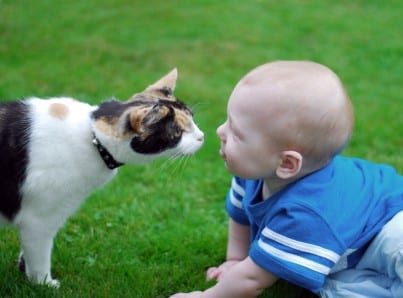Sometimes, infants and pets just don’t mix. When they do mix, your infant may have an allergic reaction. Any type of pet — dogs, guinea pigs, hamsters, cats — can cause an allergic reaction in an infant or a toddler. It can be difficult to determine whether your infant is having a seasonal allergy or is allergic to your pet. If your baby has symptoms year-round, that usually means an allergy to dust mites, mold or Fido.
Symptoms
Pet allergy symptoms include itchy and watery eyes, a rash, sneezing, a runny nose, coughing and wheezing. Babies can also get purple or bluish skin under the eyes. Doctors call this condition “allergic shiners.” Your baby doesn’t have to be around your pet to have these symptoms because if you have a pet, the allergen is all over the house. Temporarily removing your pet from the house probably won’t help you determine whether the pet is the cause. It usually takes an extended stay away from your home to tell. Once an allergy triggers, it can take a few days to get out of your baby’s system.
See an Allergist
Before you rid your home of pets, take your baby to an allergist. Even if you think you know for certain that your baby is allergic to your pet, you could be wrong. The allergist can perform a skin test to help you determine if the pet is the cause of the allergies. If so, you still may not have to remove the pet. You may just have to do a thorough cleaning of your house and keep your pet clean. It can take several months to tell if your efforts work. Of course, if your baby is definitely allergic to your pet and the cleaning doesn’t help after giving it a few months, you probably need to give your pet away.
Wait Until Age 6
If you don’t already have a pet and you or your partner have allergies, wait until your baby is at least 6 years old to try out a pet, recommends the BabyCenter website. Allergy symptoms are less pronounced in older children. An intolerable wheezing situation in a toddler, for example, might only be a slight cough in an older child.
About Dander
Cat dander tends to affect people the most, whether the allergy sufferers are infants, children or adults. They are not allergic to the animal itself; they are allergic to the dander, which is made up of skin flakes that get in the fur. A cat has smaller and stickier dander particles than a dog. Saliva is another culprit for allergies, and cats continually lick themselves, which means your baby has plenty of opportunity to encounter the saliva. Hamsters and gerbils can be bad for allergic children because of the droppings and urine these animals step in when caged, which can cause an allergic reaction in children.
Allergy Shots
When you baby is old enough, around toddler-age, ask your allergist about allergy shots. Allergy shots provide immediate relief for symptoms and can prevent future allergies. Other actions you can take are to keep pets out of the room where your baby sleeps, restrict the pet to uncarpeted rooms only, such as the kitchen, install a house filtration system and clean your house thoroughly and often.





